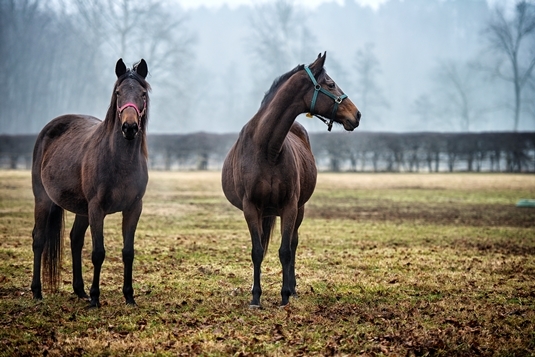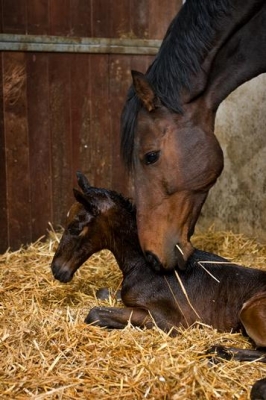|
Advice article filter
|
How do you make grass from hay?How do you make grass from hay? Research is the way to go forward. That is what Rob Krabbenborg, a nutritionist at Pavo strongly believes. The company is constantly investing in research and based on their findings, changing the recipes of their products. “Horse owners need to be confident that they are giving their horses the best of the best, when they are feeding Pavo and that is what we are constantly working on.” The most recent achievement of the horse feed manufacturers is a large-scale research on feed for mares. The reason for the research started with findings of Pavo’s “roughage monitor”. For years Pavo has been researching roughage samples that are fed to horses. “Roughages form the backbone of what horses get to eat. We need data on roughage levels to know what we need to supplement in our concentrates. Because how do you know what to put in your concentrates if you don’t know what’s in the main ingredient of the horses feed?”, explains Krabbenborg. For several years he has noticed a trend forming. “A worrisome trend, I would even say. The protein levels in roughages keeps on decreasing. People are fertilizing less and less. Horses are getting ‘natural hay’ , a lot of the time from countries where they do not fertilize their fields. The better quality roughage goes to cows and what is left over then goes to the horses. It also has something to do with money. Hay from far away countries is a lot cheaper, but nobody is asking themselves what its nutritional level actually is. There is, of course, a reason why it’s so cheap. There is almost no nutrition in it.” Grass is ideal Poor roughage is good for fat horses and sober breeds (the good-doers). However, breeders know how important it is to feed their pregnant and lactating mare high quality roughage. Krabbenborg says “The basis of having a healthy foal is determined in the last three months of gestation and the first two months after being born. Grass contains the ideal nutrients for mares. Therefore, breeders ensure that their fields are well maintained. However most mares cannot be let out onto the fields until April and therefore they are given roughage.” Pavo has already done a lot of research on the ideal feed for in the breeding world which has resulted into the Pavo Podo concept. Due to an extensive study researching the prevention of the disease OC/OCD they were able to adapt this concept and develop a supplement, where demonstrably better results were achieved. But for Pavo that wasn’t going far enough and therefore turned their attention to the mares. Krabbenborg explains : We first looked what proteins, fatty acids and vitamins grass contained. Grass is the ideal food for mares and that is why we always use it as our starting point. Our next question was: how can we, through putting sufficient nutrients in the mares pellets, create grass from a hay diet.” Clean legged foals (dry foals) Grass samples from horse fields showed that the contents of the nutrients were not much different to the nutrients found in grass that is fed to cattle. However, when it came to hay and haylage, it was a completely different story. “ That caused a big dilemma for us because that meant we had to create a different concentrate for in the summer than in the winter.” As Pavo puts the quality first, they decided to do an experiment with six big breeding yards. The results were astonishing. Bert Poppelaars, one of the participating breeders, was very enthusiastic. “After we gave the mares the new feed all our foals did very well. We didn’t have any health problems, the foals were all very clean in their joints (dry foals) and they grew well. In addition, the mares stayed in good condition which is just as important to us as they can’t suffer too much during the gestation and lactating period.” The foals were monitored through a back fat thickness measurement. That is important because we do not intend to create fatty foals. But, that did not happen. All the foals from the experiment proved to be strong, well developed and certainly not ‘mushy’. Milk analysis To complete the research, Pavo found it important to also analyse the milk of the mares. Krabbenborg laughs at the memories. “We miscalculated that a bit. If you squeeze a cows teat then milk will come out, but try doing that with a mare and her ears will go in all directions and she will keep her milk to herself. We had to try out quite a few tactics before we got a milk sample.” With help from the breeders and a persistent intern, Pavo managed to get milk samples from the mares in the first, fifth and tenth week. Analysing it wasn’t difficult. “It’s actually strange: in Zutphen (Netherlands) we have the largest dairy laboratory in the world, called Qlip, but even with all their special equipment and know how they had never analysed mares milk before.” The results confirmed our hypothesis: the enriched Pavo Podo Lac ensured a better protein and fat content in the milk. “It was actually funny to see how much horse milk differs from that of cows. The amount of sugar in horses milk is a lot higher, while protein and fat is considerably lower in comparison.” FAQ Now that research is complete, conclusions can be drawn. Krabbenborg says: “From now on in the period where mares are given roughage, we are going to put extra protein, fats and vitamins in the mare feed. We are also going to keep an eye on when that roughage season begins and ends. That can vary quite considerably per year, depending on the weather conditions. Also, we have decided not to charge any additional costs. The additions are more expensive, but the price of our mare feed will stay the same. We invest in quality so that breeders are 100% confident when giving our feed, no matter what time of year it is.” The nutritionist explains that they will consult their dealers, so that they can change their stocks on time if enriched food is necessary. According to Krabbenborg, it does not stop there. “We have, during the experiment, followed the development of the foals. This has resulted in an ideal growth curve. We have all this data and we are still coming up with ideas with what to do with it. We might make a database on our website where people can put in information about their foals where we can then compare it with the growth curve and give advice based on the given data. My ideal scenario is that we become a FAQ for the breeding world, where we can all come together and try and improve the health of our foals even more.”  
|

